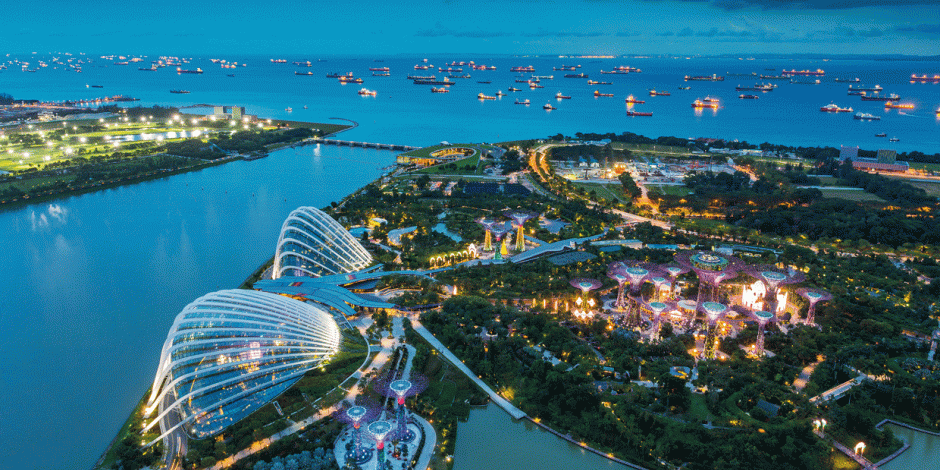Also known as the “Little Red Dot”, Singapore is an island and city-state situated just above the equator, at the southern tip of the Malay peninsulaHalbinselPeninsula. It’s one of the most densely populated countries in the world, with almost six million inhabitants. A major aviationLuftfahrt, Flugverkehraviation, maritime shippingSeeschifffahrtmaritime shipping and financial hubKnotenpunkthub, Singapore’s GDP (gross domestic product) per capitaPro-Kopf-BruttoinlandsproduktGDP per capita is one of the highest in the world.
Because of its multicultural population, Singapore has four official languages: English, Mandarin Chinese, Malay and Tamil. English is used as the lingua francaVerkehrssprachelingua franca in most administrative, educational and work settings.
A common language
Singapore became a trading postHandelspostentrading post of the British Empire in 1819 and attracted immigrants from China, Malaysia, India and other countries.
During British rule, these immigrants were assign sth.etw. zuteilenassigned to different areas of the country, based on where they came from. Each ethnic group held on to its own language and tended to socializeKontakte herstellen und pflegensocialize with people from their own communities.
This led to ethnic tensionSpannungtensions. When Singapore gained self-governanceSelbstverwaltungself-governance in 1959, and subsequentlydarauf folgend, spätersubsequently became a sovereign state in 1965, the leaders at the time recognized that racial equality and social social cohesiongesellschaftlicher Zusammenhaltcohesion were vitalentscheidendvital to the country’s ability to progress. A common language – English – was needed to unite the people.
So, instead of Chinese children going to Chinese schools and Malay children going to Malay schools and so on, English was made the language of instructionLehr-, Unterrichtssprachelanguage of instruction at all schools. English became the language that facilitate sth.etw. ermöglichen,facilitated access to knowledge and technological know-how, making Singapore the global city it has become. Today, most Singaporeans grow up bilingually, speaking English and at least one other official Singaporean language.
Singaporean English: official
Singaporean English, or “standard Singapore English”, is used in official and formal settings. Its written form features British spelling and grammar structures. Singaporean English differs from British English in its pronunciation, particularly its uniqueeinzigartig, besondersunique intonation patterns.
For example: the final syllableSilbesyllable of stress sth.etw. betonenstressed words – and also the final syllable of the last word of an utteranceÄußerungutterance – is often stressed and spoken at a higher pitchTonhöhepitch.
Unstressed words are spoken at a lower pitch but given more prominence than in British English. For example: “He like ea-ting straw-be-rries with his yo-gurt.” Because of this, Singaporean English often takes on a staccato quality.
Singlish: informal and colloquialumgangssprachlichcolloquial
Singlish, on the other hand, is used in more informal situations. When people of diverse language backgrounds come together to speak a common language, we often see the emergenceAufkommen, Entstehungemergence of a new variety of that language – and this was no different in Singapore.
Although British English was taught in schools, the people began to mix English with words and grammatical structures from their different languages. “Singlish” soon became the spoken colloquial variety used in informal interactions.
Singlish has its own unique language rules, grammar structures and individual words – which are influenced by Malay, Tamil and Mandarin, as well as by Chinese dialects, such as Hokkien, Teochew and Cantonese.
Although Singlish is sometimes called “broken English” or “pidginPidginsprache (aus mehreren Sprachen gemischte Sprache)pidgin English”, many linguists and academics view it as a legitimate variety of English that reflects the thoughts, cultures and voices of those within its community. Some argue that Singlish should be seen as a separate language in its own rightfür sich genommenin its own right. Indeed, today, more and more Singaporeans see Singlish as an important part of their national identity and heritageKultur, Geschichteheritage, and something that brings them together.
Neugierig auf mehr?
Dann nutzen Sie die Möglichkeit und stellen Sie sich Ihr optimales Abo ganz nach Ihren Wünschen zusammen.



